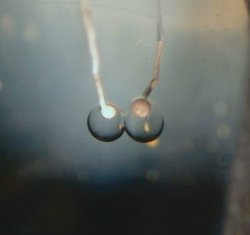Scientists at Oxford University and Duke University in the US have used tiny water droplets to build a unique microscopic light sensor.
To do it, the scientists took a protein called bacteriorhodopsin that is normally used by bacteria to produce energy, and incorporated it into a network of water droplets.
The protein reacts to green light by pumping protons across a cell membrane, which creates a positive electrical charge. By piercing the droplets with hair-thin electrodes the current generated can be measured with a sensitive amplifier.
In the future such droplets might possibly be arranged to form ‘pixels’ in an imaging array – acting as an artificial eye.
‘Using protocells, or empty artificial cells that can be filled with different cellular components, to simulate biological systems offers significant advantages to working with live cells, where there is far less control over their contents, size and function,’ said Dr Matthew Holden of Oxford University’s Department of Chemistry who conducted the research with Oxford’s Professor Hagan Bayley and Professor David Needham at Duke University.
Although protocells have provided biological and evolutionary insights before, this is the first time they have been shown working together to perform a function.
The researchers hope to create increasingly complex systems as a stepping-stone towards understanding a variety of biological functions ranging from nerve impulses to heartbeats.
For more information visit the project’s homepage here.

Microscopic light sensors created using millimetre-sized water droplets and hair-thin electrodes




Nanogenerator consumes CO2 to generate electricity
Nice to see my my views being backed up by no less a figure than Sabine Hossenfelder https://youtu.be/QoJzs4fA4fo